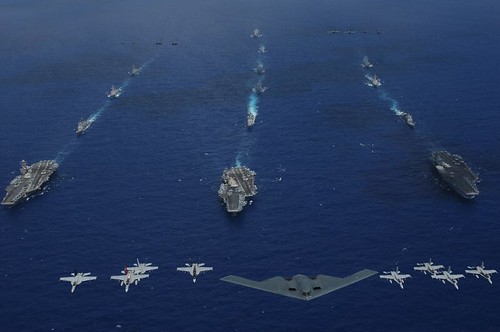* Plan sees smaller fleet, says number could drop further
* Need to replace ballistic missile submarines driving costs
* Average yearly funding of $16.8 bln needed
WASHINGTON, March 28 (Reuters) - The U.S. Navy on Wednesday submitted a 30-year shipbuilding plan to Congress that calls for a fleet of about 300 ships, 13 less than in the previous plan, and warns that the number may drop further if costs rise on any major shipbuilding programs.
The plan, required by Congress, forecast average yearly spending on new ships of about $16.8 billion per year over the next three decades, well above the historical average of around $15 billion.
Spending would average about $15.1 billion for the first 10 years, but would shoot up to $19.5 billion per year from 2023 to 2032, mainly due to the cost of replacing the current fleet of Ohio-class ballistic missile submarines, the report showed.
Deputy Defense Secretary Ashton Carter submitted the plan to Congress, saying it is affordable over the next five-year period, but "presents a resourcing challenge" beyond that, largely due to the investment required for the new submarines.
The report assumes that funding for shipbuilding will rise beginning in fiscal year 2018 and continuing through 2032, that all major ships will serve to the end of their service lives, and that the Navy will be able to avert the cost overruns that have plagued major shipbuilding programs in the past.
"If any of these assumptions prove to be faulty, future shipbuilding plans will include fewer ships and battle force inventory levels will change, inevitably falling below 300 ships," the report warned.
Defense analyst Loren Thompson of the Lexington Institute said the 30-year plan was in line with the Obama administration's budget plan for fiscal 2013 and the associated five-year plan, which had already detailed plans to delay the start of the new nuclear submarine program by two years.
The report said the current fleet numbered 282 ships as of March 23, but would grow to around 300 ships by 2019.
That future fleet would include about 12-14 ballistic missile submarines, 11 nuclear-power aircraft carriers, 48 attack submarines, zero to 4 cruise missile submarines, about 90 large surface combatants, 55 small surface combatants, 32 amphibious landing ships, 29 logistics ships, and 33 support vessels, according to the report.
Ron O'Rourke, naval analyst with the Congressional Research Service, said the latest 30-year plan added some destroyers and attack submarines, addressing projected shortfalls that had drawn congressional criticism in last year's plan.
The long range vessel construction plan includes plans to build three attack submarines and destroyers in some years, instead of just two, wh ich would be good news for the companies that build them, General Dynamics Corp and Huntington Ingalls Industries.
The Navy's latest plan calls for starting design work on a new ballistic missile submarine in fiscal year 2017, with the lead ship in the class to be obtained in fiscal 2021 at a projected cost of $11.7 billion.
The average cost for the second through 12th submarines was expected to drop to around $6.025 billion, about $1 billion less than initially expected, due to a concerted Navy effort to tamp down requirements for the new boats, it said.
The Pentagon has set an even lower affordability target for the new submarines of $5.3 billion per boat, which the Navy said it was committed to meeting.
The report said the high cost of designing and building the new submarine would have a disproportionate impact on the Navy's shipbuilding plans, straining the funding available for other ships.
Still, the Navy said it planned to continue buying aircraft carriers built by Huntington Ingalls, and would buy up to 33 DDG-51 destroyers built by both Huntington Ingalls and General Dynamics through 2030.
It also stuck to its goal of buying both versions of the new coastal combat ships built by Lockheed Martin Corp and Australia's Austal, with an eye to reaching its 55-ship target for the class by 2029.
The Navy said it was doing "everything in its power" to reduce projected shipbuilding costs during the mid-term planning period of 2023 to 2032, but said sustaining shipbuilding plans over the next 30 years would be a "key challenge."
If the Navy was unable to find the funding to pay for all its shipbuilding programs in the mid-term period, its nuclear and conventional battle force plans would have to be "dramatically changed, and the overall size of the battle force will drop below the levels needed to meet all naval presence and warfighting requirements," it said.
source:reuters



0 comments:
Post a Comment